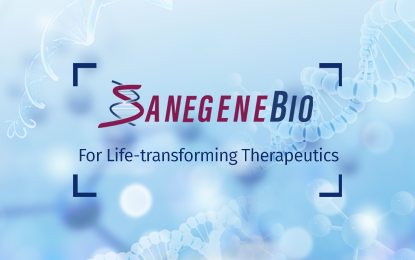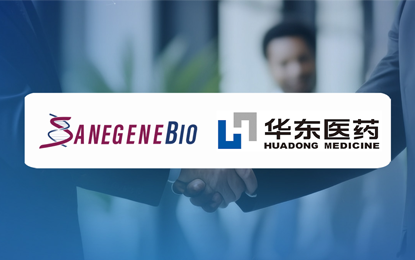By Pharma DJ
On May 31 of this year, RNA therapeutic start-up company SanegeneBio announced that its first siRNA drug, SGB-3403, targeting PCSK9, completed its first subject dosing in Australia, which means the company has entered into the clinical stage. We caught up with SanegeneBio's CEO to learn more.
Founded in 2021, SanegeneBio is an RNA therapeutic company dedicated to developing novel RNAi-based medicines. They have established hepatic and extrahepatic platforms to enable tissue-specific delivery of a wide range of RNA therapeutics to knock down disease-causing genes.
Their RNAi portfolio covers therapeutic areas including cardiovascular and metabolic diseases, immunology-related diseases, and nervous system diseases. Among them, the first drug, SGB-3403, is an siRNA drug targeting PCSK9.
SGB-3403 was developed using Sanegene' s GalNAc liver delivery platform and chemical modification platform for the potential treatment of hypercholesterolemia, mixed dyslipidemia, and atherosclerotic cardiovascular disease to reduce the risk of cardiovascular events.
PharmaDJ: Why did Sanegene choose to focus on liver-targeted RNAi drugs, and take metabolic diseases such as hyperlipemia, hypertension for the first development goal?
Sanegene: We believe that RNAi drugs will become an important treatment option in the future, gradually supplementing or even replacing traditional small molecule or antibody drugs, greatly improving patient compliance and long-term efficacy.
However, as an emerging modality, RNAi drugs are basically in a blank state in the Chinese market at present, and Sanegene is committed to bringing the RNAi drugs to Chinese patients to fill the therapeutic gap, meanwhile being dedicated to investing in novel platforms and targets to achieve more breakthroughs for the worldwide patients who need more effective, well-tolerated and convenient treatment options.
Cardiovascular disease has become the "first killer" threatening human health worldwide. In China, for example, cardiovascular disease was the leading cause of death among urban and rural residents in 2018. LDL-C is the pathogenic risk factor and needs to be closely monitored and reduced.
Currently, statins are the standard of choice to lower the LDL-C levels, however many patients with cardiovascular diseases cannot achieve ideal LDL-C levels after taking statin drugs, resulting in high risk of cardiovascular events. Therefore, there is a huge and urgent unmet medical need for a more effective and innovative treatment choice.
PharmaDJ: Could you please share the development process of SGB-3403? What are its potential advantages over existing treatments?
Sanegene: For hypercholesterolemia, the only siRNA drug worldwide, Inclisiran (targeting PCSK9), was approved for marketing in Europe in 2020. The drug has not yet been approved in China.
SGB-3403 has been shown in preclinical studies with good safety and tolerability, superior efficacy than benchmark product in multiple animal disease models, and it can reduce LDL-C by up to 40% - 70% even with lower dose and less frequency of administration, showing its potential to be the best-in-class siRNA drug targeting PCSK9. In addition, SGB-3403 applies the Sanegene' s proprietary GalNAc platform which incorporates company' s insight and expertise in the CMC of siRNA, leading to big advantages of product cost compared with other industry players.
PharmaDJ: What technology platforms does Sanegene have and what is it currently capable of accomplishing? Which of them are Sanegene's proprietary technologies?
Sanegene: Sanegene has established an integrated siRNA drug discovery platform and comprehensive internal capability to establish proprietary hepatic and extrahepatic platforms for delivering siRNA to specific tissues. We have filed 17 patents applications for our platforms and compounds, 6 of which have been converted to PCT.
The proprietary siRNA platforms allow us to develop assets with high potency, low toxicity, tissue-specific delivery, durable knockdown of disease-causing genes, which putting together generate an overall improved therapeutic profile compared with leading benchmarks.
PharmaDJ: The delivery system has a huge impact on the efficacy and safety of siRNA drugs, what are Sanegene' s important technological breakthroughs in this area?
Sanegene: Sanegene uses the most advanced conjugate delivery platform to avoid the use of lipid-based nanoparticle systems due to potential safety concerns. Through the modular design with targeting ligands, delivery enhancers, and sequences and site-specific chemical modifications, the barriers for extracellular and intracellular delivery can be well addressed.
Sanegene' s proprietary GalNAc delivery platform, for example, can efficiently and precisely target the liver cells and effectively knock down the expression of disease-causing genes for the effective treatment of liver and liver-related diseases.
The extrahepatic delivery platforms in development have been able to successfully deliver siRNA to different organs and tissues with good delivery efficiency and gene knockdown activity.
PharmaDJ: What is the company's current research and development progress for extrahepatic targeted drugs?
Sanegene: Currently, no RNAi drug based on extrahepatic targeted delivery technology has been approved worldwide. Only a few drug candidates from leading global players are in Phase 1 or 2 clinical trials, and the majority are still in pre-clinical development.
Sanegene is developing novel, specific and efficient extrahepatic delivery platforms using potential targeting ligands, including peptides, antibodies, carbohydrates, and small molecules. Since its inception, Sanegene has put great emphasis on the development of extrahepatic delivery platforms. We have achieved satisfying results in multiple tissues or cell types, e.g., central nervous system, which has been shown with great delivery efficiency and gene knockdown activity through our proprietary conjugate technology and chemical modifications.
In addition, patent applications related to the extrahepatic drug delivery platform have been filed during the R&D process, which can effectively protect our intellectual property.
PharmaDJ: In your opinion, what are the opportunities and challenges that Sanegene is facing now? How will you grasp and respond to them? What is the next overall goal of the company and the direction of seeking cooperation?
Sanegene: Sanegene successfully completed the first patient dosing of its first siRNA drug at the end of May this year. This is a very important milestone for the company, and it is the beginning of our rapid clinical development. We will continue to advance new pipelines into the clinic.
With this comes challenges and opportunities. For opportunities, siRNA is a relatively new modality especially in China and "blue ocean" compared with other so-called racetracks. Sanegene is in a very good position with a experienced, qualified and balanced team. We will accelerate both breakthroughs in novel platforms and clinical development of pipeline assets of high unmet medical needs.
That said, we do see challenges from market environment, fierce competition and organization development, which should be the general difficulties faced with biotech companies currently. Luckily in Sanegene we are in a good shape with right capability setting to sail through the tough times.
We will continue to focus on innovation as our core competency and improve the quality and productivity of our R&D. For the development of new pipeline, we will focus more on targets and indications with high unmet medical needs and balanced risk-benefit ratio, meanwhile open for collaborations with partners of partners of great synergy in clinical and commercial capability to achieve first mover advantages for most of our pipeline programs.
Hot News
-
 Dec. 01, 2023SanegeneBio Raised nearly $100 Million in Series A+ Financing Led by Tencent Investment and Yuanbio Venture Capital, to Advance Development of RNAi Therapeutics
Dec. 01, 2023SanegeneBio Raised nearly $100 Million in Series A+ Financing Led by Tencent Investment and Yuanbio Venture Capital, to Advance Development of RNAi Therapeutics
-
 Nov. 09, 2023SanegeneBio and Huadong Medicine Collaborate to Develop Novel siRNA Drugs for the Treatment of Chronic Metabolic Diseases
Nov. 09, 2023SanegeneBio and Huadong Medicine Collaborate to Develop Novel siRNA Drugs for the Treatment of Chronic Metabolic Diseases
-
 May 31, 2023Sanegene Announces Dosing of the First Subject in Phase I Trial of SGB-3403 Targeting PCSK9 for the Treatment of Hypercholesterolemia
May 31, 2023Sanegene Announces Dosing of the First Subject in Phase I Trial of SGB-3403 Targeting PCSK9 for the Treatment of Hypercholesterolemia






